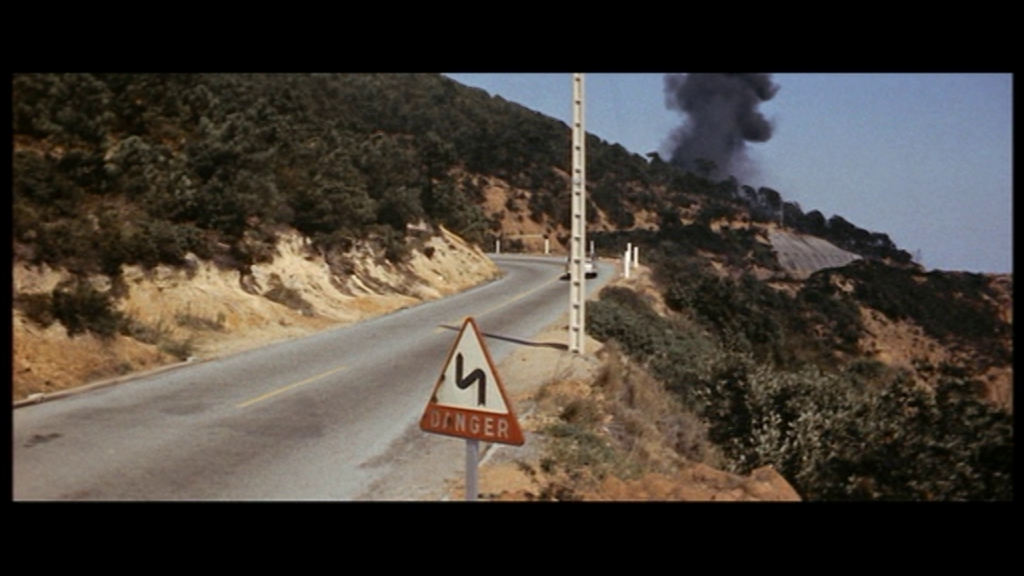
BONJOUR TRISTESSE is beautiful, odd, trashy at times — it perfectly captures the feeling if an endless summer, but brackets its lustrous Saint-Tropez Technicolor with monochrome scenes in Paris that make it all too clear the idyll is doomed. Preminger only mixed colour with b&w this one time, but it seems appropriate to his perversity that he used monochrome for the present tense. Of course it makes a clear emotional point about the joy having drained from our young protagonist’s life (and suits the particular looks of St Tropez and Paris) but of course it doesn’t withstand a literal-minded interpretation, and at the same time it’s too obvious to sublimate into symbolism.
Somewhat random side-note — just stumbled upon the fact that, while filming the Great Fire of London for FOREVER AMBER, Otto nearly incinerated Linda Darnell, eerily anticipating her eventual tragic fate by some years. It was a piece of collapsing set that did it, or nearly. And I thought, My God, Otto had form, because he nearly burned Jean Seberg to death making JOAN OF ARC, and did in fact take her eyebrows off. It may be unfair to blame him wholly, since a director is somewhat at the mercy of what the pyrotechnics people say is safe, but on the other hand, fish stinks from the head, and a director is quite able to say “That sounds kinda risky,” or “I’d like some more safety measures in place.” Otto instead follows in the tradition of his fellow Viennese Fritz Lang, who came close to creating Brigitte Helm on METROPOLIS.


There’s a smouldering death here, too, but off-screen, represented by a great black smoke signal against the azure Mediterranean sky, produced by car crash (see also ANGEL FACE), and anticipating Otto’s own accident when he was struck down and badly injured by a car (I imagine the driver’s astonishment at Mr. Freeze suddenly impacting his windscreen).




We’re in the world of Françoise Sagan, based on the novel she published at nineteen. Her youth seems to grant her a strong insight into the thought processes of teenage Cecile (Jean Seberg), with the slight disadvantage that everyone else behaves like an adolescent too. The one real adult, supposedly, Deborah Kerr’s character, is as extreme as everyone else, really, just in a different direction.
I wonder what the shoot was like? I mean, it looks like heaven: Paris and the Côte d’Azur (with Otto now starting his later shoot-it-all-on-location phase), attractive people, and David Niven on hand to stop Otto getting too beastly — Niv had stood up to Michael Curtiz (“Vhere is your script?” “I don’t need it.” “Run and get it!” “YOU fucking run and get it.”) and knew that all bullies are cowards. (It’s possible that everybody’s a coward, and bullies have just discovered a peculiarly extrovert way of handling it. It [a] works for them and [b] makes the world a more hideous place.)

The movie is a fashion show (Givenchy, Hermès, Cartier), and an art show, and a parade of beautiful, rich, foolish people we shouldn’t have any sympathy for and mostly don’t. But I found I still felt for Seberg’s spoilt brat a little, perhaps because Seberg herself was so tragic. Otto was determined to make her a star — she’d been roasted for JOAN OF ARC and the American critics wouldn’t accept her as French here either, as if it mattered. You accept she’s Niven’s daughter even though he’s English playing French. And if they’re French, what is the heavily-accented Mylene Demongeot? Doesn’t matter.
Critical hostility to Seberg was probably mostly about her flat Iowan accent, which Austrian Otto was perhaps not sensitive to — she can seem bad even when she’s emotionally on point — I remember her being wooden in THE MOUSE THAT ROARED, which came after this. Efforts to deaden the accent add layers of self-consciousness to someone whose charm ought to be in their naturalness. This is the movie where it all kind of fits.

Niven is very fine also, in a role with uncomfortable echoes of his own life — not the creepy Elektra complex stuff, the idea of the playboy who finally tries to settle down, only for fate to knife him in the back. Deborah Kerr seems like the kind of woman who could reform him. And here’s Martita Hunt, maybe the only actor to appear for Otto in the forties, fifties and sixties?


BONJOUR TRISTESSE stars Sister Clodagh; Squadron Leader Peter Carter; St. Joan of Arc; Milady de Winter; Lieutenant Joyce; Georgette Aubin; Mr. Silence; Miss Havisham; Lord Desham; Jackson’s Doxy; Sir Hugo Baskerville; Adrian Baskerville; and the Fiddler on the Roof.
















